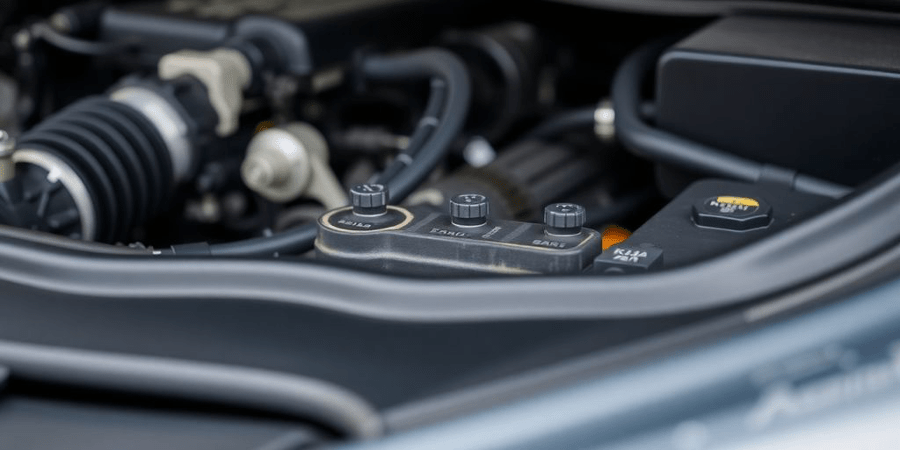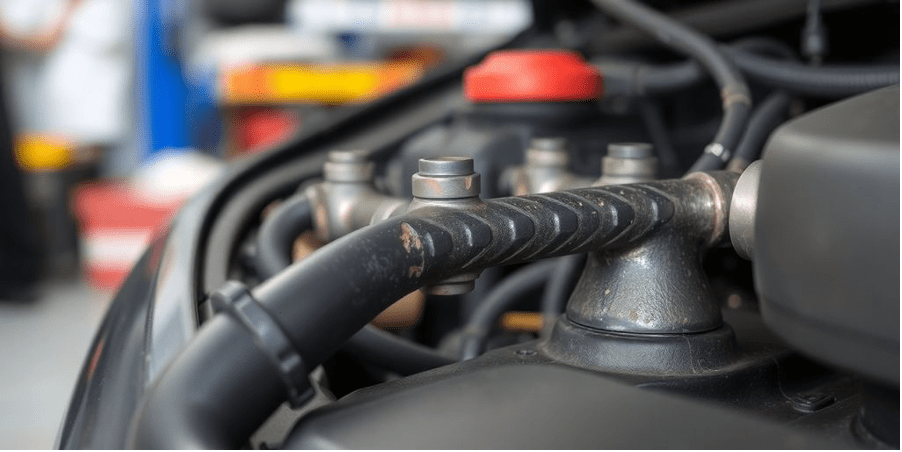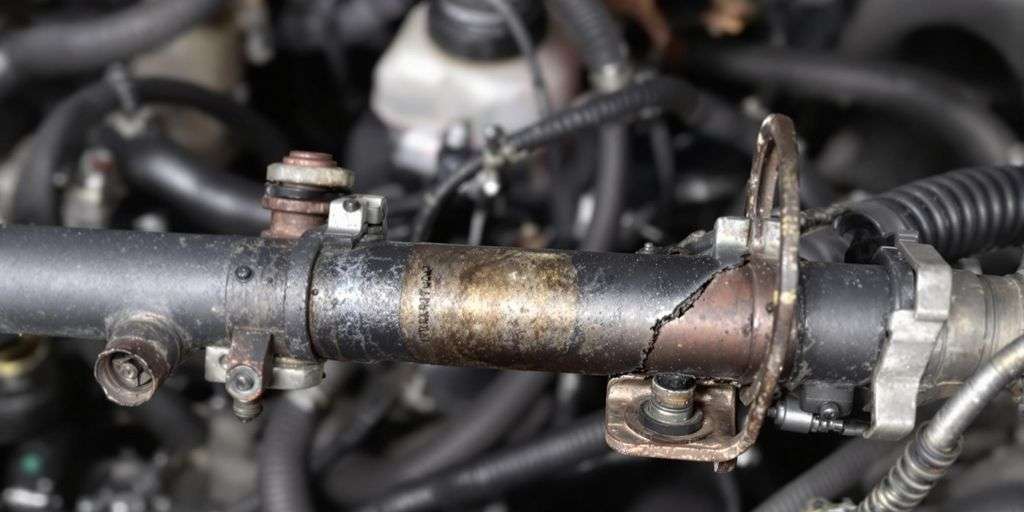Key Takeaways
- Understanding the fuel rail's role helps in deciding whether to repair or sell.
- Repair costs can be high, so weigh them against selling the car as-is.
- Private sales require honesty about the car's condition to avoid future hassles.
- Dealerships might offer less, but it's a quicker sale process.
- Online platforms give you access to more buyers, but be ready to handle lots of questions.
Understanding the Impact of a Faulty Fuel Rail
How a Faulty Fuel Rail Affects Engine Performance
A faulty fuel rail can mess up your car's engine performance big time. The fuel rail is like a highway for fuel, delivering it to the engine's cylinders. If something's off, like a leak or blockage, your engine might not get enough fuel, causing it to run rough or stall. Poor injector performance can lead to starting issues, decreased fuel economy, reduced performance, and rough engine operation. It's like trying to run a marathon with a clogged nose; you just won't perform well.
Common Symptoms of Fuel Rail Issues
Spotting fuel rail problems early can save you a lot of hassle. Here are some symptoms to watch out for:
- Engine Misfires: If your engine's skipping or chugging, a faulty fuel rail might be the culprit.
- Fuel Smell: A strong fuel smell could mean there's a leak in the fuel rail.
- Check Engine Light: This light could be triggered by a range of issues, including fuel rail problems.
The Role of the Fuel Rail in Fuel Injection
The fuel rail plays a crucial role in fuel injection. It holds the fuel under pressure before it's injected into the engine. Think of it as a reservoir that ensures each cylinder gets just the right amount of fuel at the right time. Without a properly functioning fuel rail, your car's engine might not perform efficiently, leading to increased fuel consumption and even potential damage over time.
If you suspect your fuel rail is faulty, addressing the issue sooner rather than later can prevent further engine damage and keep your car running smoothly.
Evaluating Repair Costs Versus Selling
Cost Analysis of Repairing a Faulty Fuel Rail
When dealing with a faulty fuel rail, assessing repair costs is crucial. Generally, replacing a fuel rail can range from $300 to $1,000, depending on your car's make and model. Labor costs may add another $100 to $200. If additional components like fuel injectors are affected, expect higher expenses. Weighing these costs against your car's overall value is essential. If the repair exceeds half the car's worth, selling might be a better choice.
When to Consider Selling Instead of Repairing
Sometimes, selling is more practical than repairing. If your car is older, with high mileage, or has other issues, fixing the fuel rail might not be worth it. Selling “as is” can save you from further expenses and headaches. Consider the impact of a faulty fuel rail on your car's value and buyer interest. Cars with significant defects often fetch lower offers, but this might still be preferable to costly repairs.
Impact of Fuel Rail Issues on Car Value
A defective fuel rail can significantly lower your car's market value. Buyers are wary of vehicles with unresolved mechanical problems, fearing future repairs. This perception can lead to reduced offers, sometimes by hundreds or even thousands of dollars. A car's perceived reliability is often more important than its actual condition. Potential buyers might factor in the hassle of repairs, impacting their willingness to pay top dollar. This diminished value is something to consider when deciding between repairing and selling.
Exploring Private Sale Options

Preparing Your Car for a Private Sale
Getting your car ready for a private sale can be a bit of a chore, but it's really important if you want to make a good impression on potential buyers. Start by giving your car a thorough cleaning, inside and out. A spotless car not only looks better but also suggests that you've taken good care of it. Next, gather all the important documents, like the title, service records, and any receipts for repairs. These papers can help build trust with buyers, showing them that you're honest and transparent about the car's history.
Disclosing Fuel Rail Issues to Buyers
When selling a car with a faulty fuel rail, honesty is the best policy. Be upfront about the issue to avoid any future disputes or legal troubles. Explain what a fuel rail does and how its malfunction can affect the car's performance. You might even want to mention how the powertrain control module could detect these issues. This transparency can help you build a good relationship with potential buyers, who will appreciate your honesty.
Negotiating Price with Potential Buyers
Negotiating the price is often the trickiest part of selling a car privately. Start by setting a fair price that reflects the car's condition, including the faulty fuel rail. Consider getting a mechanic's estimate for repair costs, which can serve as a bargaining chip. When negotiating, stay calm and open to offers, but don't feel pressured to accept a lowball bid. It's okay to walk away if the offer doesn't meet your expectations. Remember, the goal is to reach a deal that both you and the buyer are happy with.
Selling a car with known issues might seem daunting, but with the right approach, it can be a smooth process. Be honest, prepare well, and stay open during negotiations, and you'll likely find a buyer who appreciates your transparency.
Selling to Dealerships or Car Buying Services
Pros and Cons of Selling to a Dealership
Selling your car with a faulty fuel rail to a dealership can be a mixed bag. On the plus side, dealerships offer convenience. You don't have to deal with endless inquiries or potential buyers who might back out last minute. Plus, dealerships can handle all the paperwork, making the process smooth. On the downside, dealerships might not offer the best price. They have to make a profit, so they might give you a lower offer, especially when your car has issues.
How Car Buying Services Handle Faulty Cars
Car buying services are another option. These companies specialize in buying cars, even ones with problems. They often provide a quick sale process, which is great if you need to sell fast. However, they might also offer lower prices because they factor in the cost of repairs. It's essential to get multiple quotes to ensure you're getting a fair deal.
Maximizing Your Offer from Dealerships
If you're set on selling to a dealership, there are ways to maximize your offer. First, do your homework. Know your car's market value, even with the faulty fuel rail. Be upfront about the issue, but also highlight any positive aspects of the car, like low mileage or new tires. You can also get a pre-sale inspection to show the dealership you're being honest about the car's condition. Lastly, don't be afraid to negotiate. Dealerships expect it, so come prepared with your research and be ready to walk away if the offer isn't right.
Dealing with a faulty car can be tough, but selling it doesn't have to be. Weigh your options, be honest about your car's condition, and don't rush the process. Selling to a dealership or car buying service can be a viable path, just make sure you know what you're getting into.
Considering Trade-In Opportunities

How Trade-Ins Work with Faulty Cars
Trading in a car with a faulty fuel rail might seem tricky, but it's doable. When you trade in your vehicle, the dealership assesses its condition, including any issues like a faulty fuel rail. This evaluation helps them determine how much they're willing to offer. They'll consider repair costs and how much they can sell it for after fixing it. The trade-in process is generally faster than selling privately because dealerships handle the paperwork and repairs.
Evaluating Trade-In Offers
When you're looking at trade-in offers, don't just jump at the first one you get. It's smart to shop around and compare what different dealerships offer. Some might give you a better deal, especially if they're keen to sell you a new car. Here are a few things to keep in mind:
- Get quotes from multiple dealerships.
- Consider the total deal, including any promotions on new cars.
- Remember that the trade-in value might be lower because of the faulty fuel rail.
Negotiating a Fair Trade-In Value
Negotiating a good trade-in value is all about being informed and a bit persistent. Start by knowing your car's worth in its current condition, even with the faulty fuel rail. You can use online tools to get an estimate. When negotiating, be upfront about the car's condition but also highlight its strengths, like low mileage or recent maintenance. Dealerships expect some haggling, so don't be shy about pushing for a better offer.
Trading in might not always give you the highest return, but it offers convenience and speed, especially if you're planning to buy another car from the same dealership.
For cars that are five years or older, they might end up at an auction, which can affect the trade-in value. Cars with low mileage might fetch a better price, even with some issues.
Utilizing Online Car Selling Platforms
Best Online Platforms for Selling Cars with Issues
Selling a car with a faulty fuel rail online can be tricky, but there are plenty of platforms that can help. Each has its own perks and quirks. Choosing the right one can make a big difference in how quickly and profitably you sell your car. Some top contenders include general marketplaces like Craigslist and eBay Motors, which offer broad reach, and specialized sites like CarGurus and Autotrader, known for their car-centric audiences. Here's a quick look at what to consider:
- Craigslist: Local reach, no listing fees, but beware of scams.
- eBay Motors: Auction style can drive up prices, but fees apply.
- CarGurus: Offers market value insights, but listings can be pricey.
Creating an Effective Listing
An effective listing is your first impression, so make it count. Start with clear, honest photos showing all angles of your car, especially any problem areas. Write a straightforward description including make, model, year, mileage, and the fuel rail issue. Highlight any recent repairs or upgrades to show potential buyers the car’s value. Don't forget to set a competitive price based on research.
Handling Inquiries and Offers Online
Once your listing is live, you'll likely start getting inquiries. Responding promptly and professionally is key. Be ready to answer questions about the car’s condition, history, and the fuel rail problem. When offers come in, consider them carefully. It might be tempting to jump at the first offer, but patience can pay off. Negotiation is part of the process, so be prepared to haggle a bit to get the best deal.
Selling a car online, especially one with issues, requires patience and honesty. Keep communication open, and you'll find the right buyer eventually.
Legal and Ethical Considerations
Understanding Disclosure Laws
When selling a car with a faulty fuel rail, it's crucial to be transparent about the vehicle's condition. Disclosure laws require sellers to inform potential buyers about any known defects, including issues with the fuel rail. These laws vary by state, so it's essential to check local regulations. Failing to disclose such information can lead to legal trouble, including lawsuits or fines.
Ethical Selling Practices
Ethically, selling a car means being honest about its condition. Not only is this the right thing to do, but it also builds trust with potential buyers. Consider the following practices:
- Be upfront about the faulty fuel rail and any other issues.
- Provide maintenance records and repair quotes.
- Offer a test drive so buyers can assess the vehicle's performance.
Avoiding Legal Issues When Selling
To avoid legal problems, ensure all paperwork is in order. This includes the title, bill of sale, and any disclosures about the car's condition. It's also wise to document all communications with potential buyers, including any promises or agreements made. If you're uncertain about the legalities, consulting with a professional or legal advisor can be beneficial.
Selling a car with known defects can be tricky, but with the right approach, it can be done both legally and ethically. Transparency is key, and it can save you from future headaches.
For those dealing with recalls, recall marketing can be a helpful resource to ensure all necessary repairs are communicated to potential buyers.
Wrapping It Up
So, there you have it. Selling a car with a faulty fuel rail isn't a walk in the park, but it's not impossible either. You've got options, whether it's fixing the issue before selling, being upfront with buyers, or even going through a dealer. Each path has its own set of pros and cons, and it's all about what works best for you. Remember, honesty is key if you're selling it as-is. Buyers appreciate transparency, and it can save you headaches down the road. Whatever you decide, make sure it aligns with your needs and comfort level. Good luck out there!
Frequently Asked Questions
Can I drive my car with a faulty fuel rail?
Driving with a faulty fuel rail can be risky. It might cause the engine to run poorly or even stop working. It's best to fix the issue as soon as possible to avoid bigger problems.
How can I tell if my fuel rail is faulty?
Common signs include rough idling, trouble starting the engine, and reduced power. If you notice these, it might be time to check the fuel rail.
Is it expensive to fix a fuel rail?
The cost to fix a fuel rail can vary. It depends on the car model and the extent of the damage. Sometimes, it might be cheaper to sell the car instead of fixing it.
Should I tell buyers about the faulty fuel rail?
Yes, it's important to be honest with buyers. Let them know about any issues, including a faulty fuel rail. This builds trust and avoids legal troubles later.
Can I sell my car to a dealership with a faulty fuel rail?
Yes, dealerships often buy cars with issues, but they might offer less money. It's a quick way to sell, but you might not get the best price.
What are the best online platforms to sell a car with issues?
Websites like Craigslist, eBay Motors, and Facebook Marketplace are good options. They let you reach many potential buyers, even if your car has problems.



